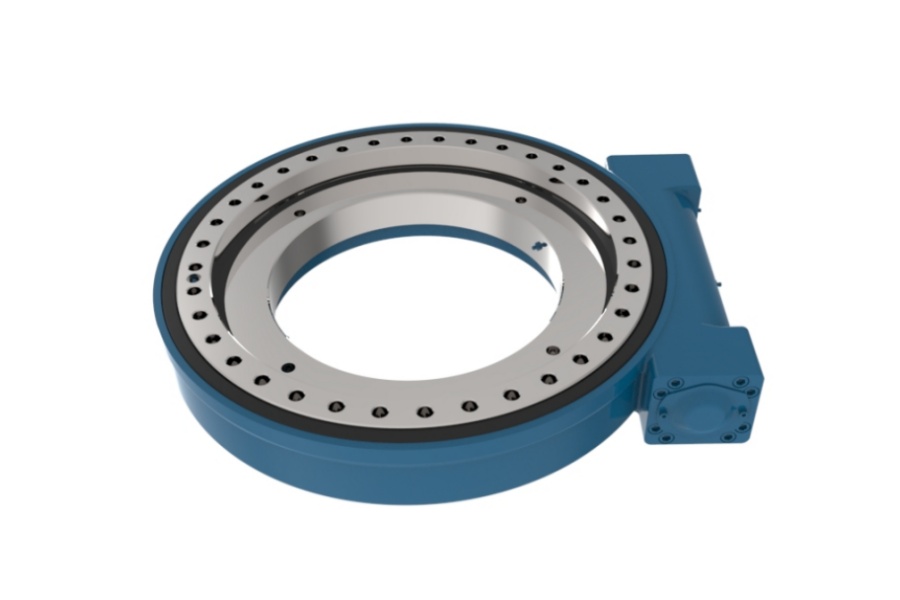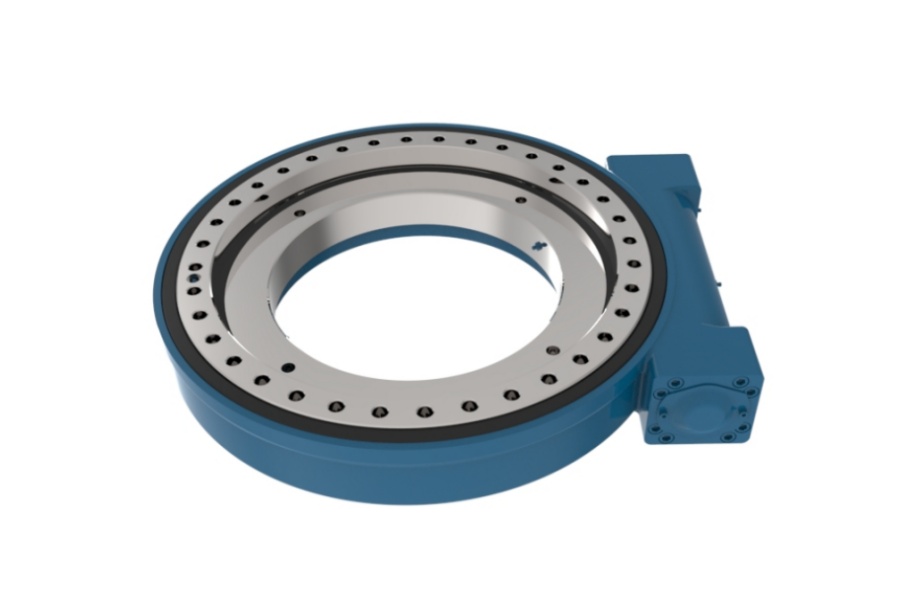
Slew Drive Classification and Selection Guide
What is Slew Drive
Slew Drive represents an integrated rotational system that combines a slewing bearing with a gear mechanism to facilitate controlled rotational movement under significant load conditions. This complete mechanical assembly incorporates all necessary components including gears, bearings, seals, and mounting interfaces into a single compact unit, providing exceptional structural integrity and operational efficiency. The fundamental purpose of a slew drive is to convert input power from various sources into precise output rotation while simultaneously supporting substantial axial, radial, and moment loads. This integrated approach to rotational power transmission has become essential across numerous industries where space constraints, precision requirements, and reliability are paramount concerns. Understanding the different types and their specific characteristics forms the foundation for proper selection and application of these critical components.

Slew Drive Classification and Selection Guide
The proper classification and selection of slew drives requires thorough understanding of various technical parameters and application requirements to ensure optimal performance and longevity in diverse operational environments.
Slew drives are primarily classified according to their internal rolling element configuration and gear arrangement. Single ball row designs represent the most basic configuration, suitable for applications with moderate load requirements and relatively simple operational conditions. Double ball row designs provide enhanced load capacity and improved moment resistance, making them ideal for applications involving significant off-center loading or dynamic force variations. Crossed roller designs offer the highest precision and load capacity in compact dimensions, utilizing cylindrical rollers arranged at 90-degree angles to handle combined loads efficiently. Gear configurations further differentiate slew drives, with external gear types providing direct drive interface options while internal gear designs offer compact installation profiles and enhanced protection for the gear teeth.
Selection criteria must address multiple technical considerations to ensure compatibility with application requirements. Load capacity analysis forms the fundamental selection parameter, requiring accurate calculation of all anticipated load types including axial, radial, and moment loads under both static and dynamic conditions. The selected drive must demonstrate adequate safety margins beyond maximum anticipated loads, typically following established industry standards and manufacturer recommendations. Operational speed requirements significantly influence drive selection, with different designs offering varying maximum rotational capabilities and acceleration characteristics. Precision requirements dictate the appropriate gear quality and backlash specifications, with applications demanding high positional accuracy requiring precision-ground gears and minimal clearance designs.
Environmental considerations play a crucial role in drive selection. Temperature ranges affect material selection, lubrication requirements, and thermal expansion considerations. Contamination protection requirements dictate sealing system specifications, with IP ratings defining appropriate protection levels against dust, moisture, and other contaminants. Chemical exposure possibilities necessitate compatible material selections and surface treatments. Operational cycle requirements including continuous versus intermittent operation, duty cycles, and expected service life influence component selection and design specifications. Mounting configuration compatibility with existing equipment structures must be verified, including flange patterns, bolt circle diameters, and interface specifications.
Technical support and lifecycle considerations complete the selection process. Manufacturer documentation quality, technical support availability, and engineering assistance capabilities significantly impact installation and maintenance success. Spare parts availability, lead times, and long-term product support affect operational continuity and maintenance planning. Certification requirements including ISO standards, industry-specific qualifications, and regulatory compliance needs must be addressed through appropriate manufacturer capabilities and product documentation. Cost considerations must balance initial investment against total cost of ownership, considering maintenance requirements, expected service life, and operational efficiency characteristics.
Characteristics of Slew Drive
Slew drives possess distinctive characteristics that make them indispensable for heavy-duty rotational applications. Their most significant feature is their integrated design philosophy, which combines multiple functional components into a single compact unit, providing substantial space savings and structural simplicity compared to traditional separate systems. These drives deliver exceptional load-handling capability, simultaneously managing complex load combinations including axial forces, radial loads, and moment loads through robust construction and precision-engineered components. The precision positioning capability represents another critical characteristic, with many systems achieving positioning accuracy within arc-minute ranges through precision gearing and minimal backlash design. Durability is enhanced through the use of high-strength alloy steels, advanced heat treatment processes, and comprehensive sealing systems that ensure reliable performance in demanding industrial environments. The modular design approach facilitates easier installation and maintenance, with standardized mounting interfaces and accessible service points that simplify integration and upkeep while reducing total cost of ownership.
Applications of Slew Drive
The unique combination of strength, precision, and compactness enables slew drives to serve critical functions across numerous industrial sectors and applications. In renewable energy applications, they form the core component of solar tracking systems, precisely orienting photovoltaic panels to maximize energy capture throughout the day, while also serving in wind turbines for pitch and yaw control mechanisms that optimize performance and protect against extreme weather conditions. Construction equipment extensively utilizes slew drives in excavators, cranes, and aerial work platforms, where they provide the rotational capability for booms, platforms, and lifting mechanisms that require smooth operation under variable loads. Material handling equipment incorporates these drives in rotary conveyors, stackers, and manipulators that require controlled rotation with precise positioning capabilities. Industrial automation systems employ slew drives in robotic welding cells, indexing tables, and automated assembly lines where accurate rotational positioning is essential for manufacturing precision. The aerospace and defense sectors utilize them in radar systems, satellite communication antennas, and weapon platforms that require accurate positioning and stability under demanding operational conditions. Even medical equipment manufacturers incorporate precision slew drives in advanced imaging systems like CT and MRI scanners where smooth, reliable rotation is critical for diagnostic accuracy. Additional applications include mining equipment, marine deck machinery, agricultural implements, and telescope positioning systems, demonstrating the remarkable versatility of these components across virtually every sector requiring controlled rotational movement under load.
Factors Influencing the Price of Slew Drive
The cost structure of slew drives is determined by numerous technical and commercial factors that reflect their engineering complexity and performance capabilities. The primary cost driver is the physical size and load capacity rating, with larger units designed for higher loads commanding significantly higher prices due to increased material requirements, more complex manufacturing processes, and enhanced quality control measures. The selection of materials represents another significant factor, with high-grade alloy steels, specialized coatings, and advanced heat treatment processes adding substantial value while increasing manufacturing expenses related to material procurement and processing. Manufacturing precision constitutes a major cost component, as precision-ground gear teeth, honed bearing surfaces, and exacting tolerance control require advanced machinery, skilled labor, and extensive quality verification procedures, all contributing to higher production costs. The type and complexity of the drive mechanism influence price, with gear-type systems generally commanding premium pricing compared to worm drives due to their higher efficiency and speed capabilities, while planetary or hybrid systems offering special features further increase costs. Additional features such as integrated motors, brakes, sensors, or special sealing systems designed for extreme environments add functionality but also increase the overall cost through additional components and assembly complexity. Certification requirements including ISO standards, industry-specific qualifications, and third-party verification processes contribute to the total cost through testing and documentation expenses. Finally, brand reputation, warranty coverage, after-sales support services, and order volume considerations contribute to the total cost of ownership, with established manufacturers typically commanding premium prices based on proven reliability and comprehensive technical support offerings.
Supplier of Slew Drive
LYRADRIVE represents a leading manufacturer and global supplier of high-performance slew drive solutions, offering comprehensive rotational drive systems that meet rigorous application requirements across various industries. The company maintains an unwavering commitment to quality through advanced manufacturing processes, stringent quality control measures, and continuous product development initiatives. Their product portfolio encompasses both standard and customized solutions designed to address specific load capacity, environmental condition, and integration requirements, supported by extensive technical expertise and engineering consultation services. LYRADRIVE's technical support team provides comprehensive assistance throughout the selection process, helping customers identify optimal solutions that balance performance requirements with economic considerations. By focusing on reliability, performance, and customer satisfaction, LYRADRIVE has established itself as a trusted partner for businesses that depend on precision rotational drive technology, offering competitive solutions that deliver long-term value through superior engineering and manufacturing excellence.



